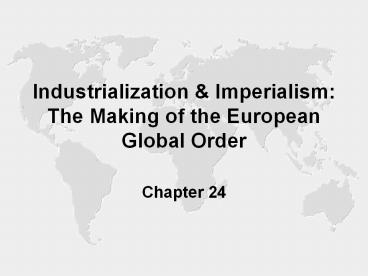Industrialization - PowerPoint PPT Presentation
1 / 17
Title:
Industrialization
Description:
Industrialization & Imperialism: The Making of the European Global Order Chapter 24 Map Exercise 24.1 European Colonial Territories, Before and After 1800 (page 570) 1. – PowerPoint PPT presentation
Number of Views:188
Avg rating:3.0/5.0
Title: Industrialization
1
Industrialization ImperialismThe Making of
the European Global Order
- Chapter 24
2
Map Exercise 24.1European Colonial Territories,
Before and After 1800 (page 570)
- 1. The World in 1763
- a. What was the largest European Empire?
- b. Which European nations had overseas empires?
- 2. The World in 1830
- a. Which European nation had the largest empire?
- b. Which European nations had largely lost their
empires? - c. What events between 1763 1830 would account
for their changes?
3
Map Exercise 24.2 24.3The Stages of Dutch
Expansion in Java (page 571)The Growth of the
British Empire in India (page 573)
- 1. Early expansions prior to 1800
- a. What lands did the British Dutch control?
- b. How would you describe the pattern of
acquisition control? - 2. Expansion after 1800
- a. What patterns did British Dutch pursue in
acquiring colonies? - b. What would be the benefit of having allies
dependent states?
4
Map Exercise 24.4The Partition of Africa (page
579)
- 1. Map around 1870
- a. Which European nations control what areas?
- b. Describe the pattern of settlement.
- c. What might account for this pattern of
control? - 2. Map around 1914
- a. Which 2 states have gotten the largest African
empires? - b. What other states have African empires?
- c. Why might Germany be considered a spoiler in
Africa?
5
(No Transcript)
6
Land empires in Asia
early partition of world haphazard
officials would expand authority then report home
Dutch in Java
1. pay tribute 2. monopoly on spices 3. support
winner of Mataram throne 4. regularly
intervene 5. gain land
7
British rule in India
pivotal
much like Dutch in Java
British East India Company
Mughal Empire disintegrates British intervene
with sepoys
global rivalry with French
Plassey (1757) - control of Bengal
8
Consolidation of British Rule
Presidencies Calcutta, Madras, Bombay -
directly govern territories
other regions controlled by agents in Indian court
19th c. major colonial possession
Sepoys
Indian ports
- raw materials - markets for manufactured
goods - overseas investment
9
early colonial society leave Asian social
systems intact
formed new top class previous rulers do
administrative work
accommodate to indigenous culture
Social reform
late 18th century - corruption in BEI Co
reforms - made more accountable to British govt
re-make Indian society
10
Industrial Rivalries
industrialization increases Western military
superiority
Western nations become unchallenged masters of
other civilizations
- increase economic competition - increase
political rivalries
British dominate til 1850 - then Belgium,
France, Germany US
11
mass produced weapons
Colonial Wars
machine guns
railroads steamships
few natives could compete
1914 all Africa fallen to Europeans - Liberia
Ethiopia not colonies - SE Asia only
Siam free
- China, Persia Middle east unoccupied - yet
strong Euro influence
12
Patterns of Dominance
tropical dependencies - Africa, Asia Sth
Pacific - few Europeans rule many indigenous
White Dominions - Canada Australia -
inhabited mostly by Europeans, few natives -
19th century self government
contested settler colonies - Sth Africa,
Algeria, New Zealand, Kenya, Hawaii - Europeans
indigenous clash over control culture
13
Colonial Regimes
Europeans exploit ethnic cultural divisions
minorities favored
small numbers of Euros administer
indigenous officials work at local levels
European racial prejudices
Asians - more opportunities
stunt growth of middle class
14
Changing social relations
tension b/t ruler ruled
- live in segregated communities - laws against
miscegenation
white supremacy
Shifts in Economies
introduction in late 1800s of new agricultural
techniques
work harder to produce more
15
- cheap consumer goods - increased taxation -
forced labor
reduced to dependence on Euro nations
railroads roads for transport of raw materials
export crops
profits to Europe
16
Settler Colonies
parallels between Canada, Australia Sth Africa
temperate climates, few diseases
Australia - British - 1840s - stay on
coast - drove indigenous inland - thinly
populated - little resistance - peaceful,
self-governing
Canada - British - 1600s - move inland -
drove indigenous inland - some resistance -
Anglo-French friction - peaceful,
self-governing
Sth Africa - Afrikaners - 1600s - stay on
coast - thinly populated - little
resistance - enslaved interbred -
conflict b/t British Afrikaners - Afrikaners
move inland, form 2 republics
17
Pacific
demographic disaster social disruption
New Zealand 1790s - Maoris suffer, disease,
alcoholism - adjust, Christianity, farming
- 1850s pushed to interior - use legal,
political education systems to protect culture
Hawaii 1770s - Kamehameha works with
British - royalty adopts western ways -
encourage export western business -
Christianity - Americans take over 1898




























![Forecast on China Industrial Robot Industry[2015-2019] PowerPoint PPT Presentation](https://s3.amazonaws.com/images.powershow.com/8334715.th0.jpg?_=20190501113)


![Market Report on China Industrial Robot Industry [2015-2019] PowerPoint PPT Presentation](https://s3.amazonaws.com/images.powershow.com/8336262.th0.jpg?_=201512240310)